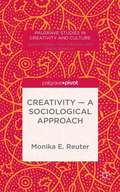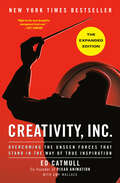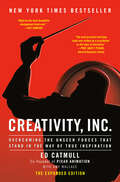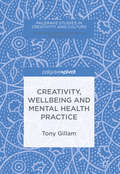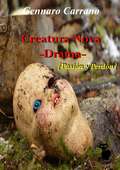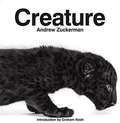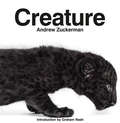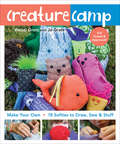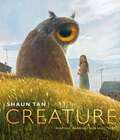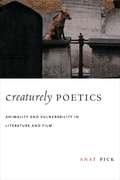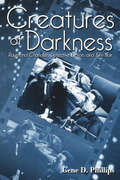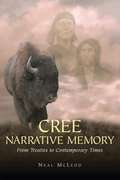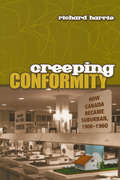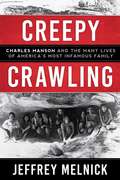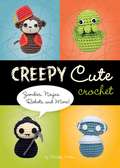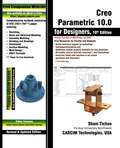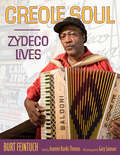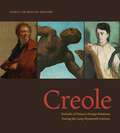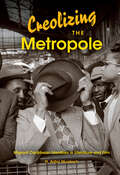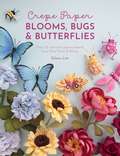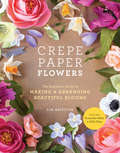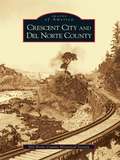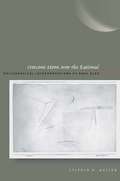- Table View
- List View
Creativity – A Sociological Approach
by Monika E. Reuter Hao TanIntroducing the first macro-sociological perspective on the concept of creativity this book includes a review of ten domains which have studied creativity. It also explores the results of a six-year on-going research project comparing students' ideas on creativity with employers' and industry professionals' views.
Creativity, Inc. (The Expanded Edition): Overcoming the Unseen Forces That Stand in the Way of True Inspiration
by Amy Wallace Ed CatmullThe co-founder and longtime president of Pixar updates and expands his 2014 New York Times bestseller on creative leadership, reflecting on the management principles that built Pixar&’s singularly successful culture, and on all he learned during the past nine years that allowed Pixar to retain its creative culture while continuing to evolve.&“Might be the most thoughtful management book ever.&”—Fast Company For nearly thirty years, Pixar has dominated the world of animation, producing such beloved films as the Toy Story trilogy, Finding Nemo, The Incredibles, Up, and WALL-E, which have gone on to set box-office records and garner eighteen Academy Awards. The joyous storytelling, the inventive plots, the emotional authenticity: In some ways, Pixar movies are an object lesson in what creativity really is. Here, Catmull reveals the ideals and techniques that have made Pixar so widely admired—and so profitable. As a young man, Ed Catmull had a dream: to make the first computer-animated movie. He nurtured that dream as a Ph.D. student, and then forged a partnership with George Lucas that led, indirectly, to his founding Pixar with Steve Jobs and John Lasseter in 1986. Nine years later, Toy Story was released, changing animation forever. The essential ingredient in that movie&’s success—and in the twenty-five movies that followed—was the unique environment that Catmull and his colleagues built at Pixar, based on philosophies that protect the creative process and defy convention, such as:• Give a good idea to a mediocre team and they will screw it up. But give a mediocre idea to a great team and they will either fix it or come up with something better.• It&’s not the manager&’s job to prevent risks. It&’s the manager&’s job to make it safe for others to take them.• The cost of preventing errors is often far greater than the cost of fixing them.• A company&’s communication structure should not mirror its organizational structure. Everybody should be able to talk to anybody.Creativity, Inc. has been significantly expanded to illuminate the continuing development of the unique culture at Pixar. It features a new introduction, two entirely new chapters, four new chapter postscripts, and changes and updates throughout. Pursuing excellence isn&’t a one-off assignment but an ongoing, day-in, day-out, full-time job. And Creativity, Inc. explores how it is done.
Creativity, Inc.: Overcoming the Unseen Forces That Stand in the Way of True Inspiration
by Amy Wallace Ed CatmullCreativity, Inc. is a book for managers who want to lead their employees to new heights, a manual for anyone who strives for originality, and the first-ever, all-access trip into the nerve center of Pixar Animation—into the meetings, postmortems, and “Braintrust” sessions where some of the most successful films in history are made. It is, at heart, a book about how to build a creative culture—but it is also, as Pixar co-founder and president Ed Catmull writes, “an expression of the ideas that I believe make the best in us possible.”<P><P> For nearly twenty years, Pixar has dominated the world of animation, producing such beloved films as the Toy Story trilogy, Monsters, Inc., Finding Nemo, The Incredibles, Up, and WALL-E, which have gone on to set box-office records and garner thirty Academy Awards. The joyousness of the storytelling, the inventive plots, the emotional authenticity: In some ways, Pixar movies are an object lesson in what creativity really is. Here, in this book, Catmull reveals the ideals and techniques that have made Pixar so widely admired—and so profitable.<P> As a young man, Ed Catmull had a dream: to make the first computer-animated movie. He nurtured that dream as a Ph.D. student at the University of Utah, where many computer science pioneers got their start, and then forged a partnership with George Lucas that led, indirectly, to his founding Pixar with Steve Jobs and John Lasseter in 1986. Nine years later, Toy Story was released, changing animation forever. The essential ingredient in that movie’s success—and in the thirteen movies that followed—was the unique environment that Catmull and his colleagues built at Pixar, based on philosophies that protect the creative process and defy convention, such as:<P> * Give a good idea to a mediocre team, and they will screw it up. But give a mediocre idea to a great team, and they will either fix it or come up with something better.<P> * If you don’t strive to uncover what is unseen and understand its nature, you will be ill prepared to lead. <P> * It’s not the manager’s job to prevent risks. It’s the manager’s job to make it safe for others to take them.<P> * The cost of preventing errors is often far greater than the cost of fixing them. <P> * A company’s communication structure should not mirror its organizational structure. Everybody should be able to talk to anybody.<P> Chosen for Mark Zuckerberg's "A Year of Books"
Creativity, Inc.: Overcoming the Unseen Forces That Stand in the Way of True Inspiration
by Amy Wallace Ed CatmullFrom Ed Catmull, co-founder (with Steve Jobs and John Lasseter) of Pixar Animation Studios, comes an incisive book about creativity in business—sure to appeal to readers of Daniel Pink, Tom Peters, and Chip and Dan Heath.Creativity, Inc. is a book for managers who want to lead their employees to new heights, a manual for anyone who strives for originality, and the first-ever, all-access trip into the nerve center of Pixar Animation—into the meetings, postmortems, and &“Braintrust&” sessions where some of the most successful films in history are made. It is, at heart, a book about how to build a creative culture—but it is also, as Pixar co-founder and president Ed Catmull writes, &“an expression of the ideas that I believe make the best in us possible.&”For nearly twenty years, Pixar has dominated the world of animation, producing such beloved films as the Toy Story trilogy, Monsters, Inc., Finding Nemo, The Incredibles, Up, and WALL-E, which have gone on to set box-office records and garner thirty Academy Awards. The joyousness of the storytelling, the inventive plots, the emotional authenticity: In some ways, Pixar movies are an object lesson in what creativity really is. Here, in this book, Catmull reveals the ideals and techniques that have made Pixar so widely admired—and so profitable.As a young man, Ed Catmull had a dream: to make the first computer-animated movie. He nurtured that dream as a Ph.D. student at the University of Utah, where many computer science pioneers got their start, and then forged a partnership with George Lucas that led, indirectly, to his founding Pixar with Steve Jobs and John Lasseter in 1986. Nine years later, Toy Story was released, changing animation forever. The essential ingredient in that movie&’s success—and in the thirteen movies that followed—was the unique environment that Catmull and his colleagues built at Pixar, based on philosophies that protect the creative process and defy convention, such as:• Give a good idea to a mediocre team, and they will screw it up. But give a mediocre idea to a great team, and they will either fix it or come up with something better.• If you don&’t strive to uncover what is unseen and understand its nature, you will be ill prepared to lead. • It&’s not the manager&’s job to prevent risks. It&’s the manager&’s job to make it safe for others to take them.• The cost of preventing errors is often far greater than the cost of fixing them. • A company&’s communication structure should not mirror its organizational structure. Everybody should be able to talk to anybody.• Do not assume that general agreement will lead to change—it takes substantial energy to move a group, even when all are on board.
Creativity, Wellbeing and Mental Health Practice (Palgrave Studies in Creativity and Culture)
by Tony GillamThis book argues that some aspects of mental health practice have become mechanical, joyless and uninspiring, leading to a loss of creativity and wellbeing. A high level of wellbeing is essential to mental health and contemporary mental health care – and creativity is at the heart of this. A greater awareness of everyday creativity, the arts and creative approaches to mental health practice, learning and leadership can help us reinvent and reinvigorate mental health care. This, combined with a clearer understanding of the complex concept of wellbeing, can enable practitioners to adopt fresh perspectives and roles that can enrich their work. Creativity and wellbeing are fundamental to reducing occupational stress and promoting professional satisfaction. Introducing a new model of creative mental health care combined with recommendations for wellbeing, Creativity, Wellbeing and Mental Health Practice is a practical, evidence-based book for students, practitioners and researchers in mental health nursing and related disciplines.
Creatura Nova: Pasión y perdón
by Gennaro CarranoAtemporal drama en el que autor Gennaro Carrano nos muestra los polos opuestos del ser humano: la extrema maldad y la bondad absoluta y cuyo final soprenderá al lector por la crudeza de los hechos. La historia proviene de una época lejana y de un lugar que bien podría estar más cercano de lo que imaginamos. Dos hombres nos la traen, tan distantes entre sí como el tiempo y el lugar del mismo. Felice, poeta de la alta sociedad y Valerio, un hombre sencillo. El impulso de contarla surge de un sentimiento vacilante, el deseo de comunicar la deriva de sentimientos ignorados y el impulso de deshacerse de una pesada carga. Dos hermanos son los protagonistas de la historia: Verginia y Adelfo. La miseria, la soledad, la ignorancia, la ira y la frustración pueden ser una mezcla explosiva para cualquier hombre que no esté acostumbrado a verse por dentro.
Creature
by Andrew ZuckermanPhotographer Andrew Zuckerman's strikingly detailed images of animals from around the world are as delightful as they are inspiring. This collection of astonishing studio portraits of 175 wild creatures--from baby leopards to parrots, bears, mandrills, and many more--are stunningly foregrounded against white backgrounds, depicting their subjects with rare sensitivity, insight, humor, and wonder. Zuckerman--also an up-and-coming filmmaker, whose first short film, High Falls, premiered at the Sundance Film Festival in 2007--has created a volume perfect for animal lovers, photography fans, and anyone fascinated by the world around us. Creature is a beautiful and thought-provoking look at the fragile wonders of the natural world.
Creature
by Andrew ZuckermanPhotographer Andrew Zuckerman's strikingly detailed images of animals from around the world are as delightful as they are inspiring. This collection of astonishing studio portraits of 175 wild creatures—from baby leopards to parrots, bears, mandrills, and many more—are stunningly foregrounded against white backgrounds, depicting their subjects with rare sensitivity, insight, humor, and wonder. Zuckerman—also an up-and-coming filmmaker, whose first short film, High Falls, premiered at the Sundance Film Festival in 2007—has created a volume perfect for animal lovers, photography fans, and anyone fascinated by the world around us. Creature is a beautiful and thought-provoking look at the fragile wonders of the natural world. Plus, this is the fixed format version, which includes beautiful high-resolution images.
Creature Camp: Make Your Own • 18 Softies to Draw, Sew & Stuff
by Wendi Gratz Jo GratzBy a mother and daughter duo: &“a bit of a &‘learn to sew&’ book for children . . . provide[s] ample inspiration without intimidation for young crafters&” (Publishers Weekly). This collection of 18 skill-building projects teaches children with no sewing experience how to sew their very own cuddly pals. From sewing on buttons to putting in zippers, this guide walks kids step-by-step through various skill levels. They will learn to embroider, turn corners, and make curves with these fun designs. Multiple examples of each project encourage them to explore ideas. Featuring shapes, critters, and monsters that appeal to kids&’ imagination, the projects build on skills and develop creativity. &“Written for children by Wendi and her daughter Jo . . . a book of sewing basics focusing on creating fun stuffed creatures, and it&’s suitable for new or experienced sewists ages 9 and up. It&’s kid-tested and approved, because all of the sewing was done by 11-year-old Jo and her friends . . . With Christmas coming, I can&’t think of a more perfect book for kids and grown-ups alike. There is just so much cuteness that needs to be stitched and gifted!&”—Wild Olive Blog
Creature Features: Draw Amazing Monsters & Aliens
by Randy MartinezPrepare to scare . . .Open this book, grab a pen, and give life to the monsters that lurk in your imagination. Creature Features shows you how to draw all things creepy, slimy and fantastical. More than 40 step-by-step demonstrations take you from start to finish as you master techniques for drawing the scariest beings on the planet and beyond, including dragons, zombies, vampires, aliens, demons, werewolves and many more.Author Randy Martinez takes a no-fear approach to drawing. As an officially licensed artist for Lucasfilm, Ltd., he's mastered the art of drawing full-color images of some of your most favorite creatures from popular comics and films. Taking it one step at a time, you'll be drawing like a pro right down to the last detail—from evil eyes and terrifying teeth to pointy nails and sharp scales.With Creature Features, being freaky has never been more fun. Get in touch with your dark side, and get drawing today!
Creature: Paintings, Drawings, And Reflections
by Shaun TanFrom the creator of THE ARRIVAL, a collection of essays illuminating his thoughts and advice for writers and artists, young and old.Shaun Tan is one of the world's most highly acclaimed narrative artists—his stories and images are loved by countless young and not-so-young readers around the world. Drawing upon 25 years as a picture book and comics creator, painter, and filmmaker, CREATURE explores the central obsession of this visionary artist, from casual doodles to studied oil-paintings. Beyond sketches for acclaimed works such as THE ARRIVAL, THE LOST THING, and TALES FROM OUTER SUBURBIA, this volume collects together for the first time unseen and stand-alone illustrations, each resonant with unwritten tales of their own. Detailed commentary by the artist offers an entertaining insight into the endless allure of imaginary, non-human beings and what they might tell us about our so-called "normal" human selves. Artists, writers, students, dreamers, and anyone interested in the deeper undercurrents of creativity, myth, and visual metaphor will find inspiration in these pages.
Creaturely Poetics: Animality and Vulnerability in Literature and Film
by Anat PickSimone Weil once wrote that "the vulnerability of precious things is beautiful because vulnerability is a mark of existence," establishing a relationship between vulnerability, beauty, and existence transcending the separation of species. Her conception of a radical ethics and aesthetics could be characterized as a new poetics of species, forcing a rethinking of the body's significance, both human and animal. Exploring the "logic of flesh" and the use of the body to mark species identity, Anat Pick reimagines a poetics that begins with the vulnerability of bodies, not the omnipotence of thought. Pick proposes a "creaturely" approach based on the shared embodiedness of humans and animals and a postsecular perspective on human-animal relations. She turns to literature, film, and other cultural texts, challenging the familiar inventory of the human: consciousness, language, morality, and dignity. Reintroducing Weil's elaboration of such themes as witnessing, commemoration, and collective memory, Pick identifies the animal within all humans, emphasizing the corporeal and its issues of power and freedom. In her poetics of the creaturely, powerlessness is the point at which aesthetic and ethical thinking must begin.
Creatures of Darkness: Raymond Chandler, Detective Fiction, and Film Noir
by Gene D. Phillips“[An] exhaustively researched survey of Raymond Chandler’s thorny relationship with Hollywood during the classic period of film noir.” —Alain Silver, film producer and authorRaymond Chandler’s seven novels, including The Big Sleep (1939) and The Long Goodbye (1953), with their pessimism and grim realism, had a direct influence on the emergence of film noir. Chandler worked to give his crime novels the flavor of his adopted city, Los Angeles, which was still something of a frontier town, rife with corruption and lawlessness. In addition to novels, Chandler wrote short stories and penned the screenplays for several films, including Double Indemnity (1944) and Strangers on a Train (1951). His work with Billy Wilder and Alfred Hitchcock on these projects was fraught with the difficulties of collaboration between established directors and an author who disliked having to edit his writing on demand.Creatures of Darkness is the first major biocritical study of Chandler in twenty years. Gene Phillips explores Chandler’s unpublished script for Lady in the Lake, examines the process of adaptation of the novel Strangers on a Train, discusses the merits of the unproduced screenplay for Playback, and compares Howard Hawks’s director’s cut of The Big Sleep with the version shown in theaters. Through interviews he conducted with Wilder, Hitchcock, Hawks, and Edward Dmytryk over the past several decades, Phillips provides deeper insight into Chandler’s sometimes difficult personality.Chandler’s wisecracking private eye, Philip Marlowe, has spawned a thousand imitations. Creatures of Darkness lucidly explains the author’s dramatic impact on both the literary and cinematic worlds, demonstrating the immeasurable debt that both detective fiction and the neo-noir films of today owe to Chandler’s stark vision.
Cree Narrative Memory: From Treaties To Contemporary Times
by Neal McLeodNeal McLeod examines the history of the nêhiyawak (Cree People) of western Canada from the massive upheavals of the 1870s and the reserve period to the vibrant cultural and political rebirth of contemporary times. Central to the text are the narratives of McLeod's family, which give first hand examples of the tenacity and resiliency of the human spirit while providing a rubric for reinterpreting the history of Indigenous people, drawing on Cree worldviews and Cree narrative structures. <p><p> In a readable style augmented with extensive use of the Cree language throughout, McLeod draws heavily on original research, the methodology of which could serve as a template for those doing similar work. While the book is based on the Cree experience of the Canadian prairies, its message and methodology are applicable to all Indigenous societies.
Creeping Conformity
by Richard HarrisCreeping Conformity, the first history of suburbanization in Canada, provides a geographical perspective - both physical and social - on Canada's suburban past. Shaped by internal and external migration, decentralization of employment, and increased use of the streetcar and then the automobile, the rise of the suburb held great social promise, reflecting the aspirations of Canadian families for more domestic space and home ownership.After 1945 however, the suburbs became stereotyped as generic, physically standardized, and socially conformist places. By 1960, they had grown further away - physically and culturally - from their respective parent cities, and brought unanticipated social and environmental consequences. Government intervention also played a key role, encouraging mortgage indebtedness, amortization, and building and subdivision regulations to become the suburban norm. Suburban homes became less affordable and more standardized, and for the first time, Canadian commentators began to speak disdainfully of 'the suburbs,' or simply 'suburbia.' Creeping Conformity traces how these perceptions emerged to reflect a new suburban reality. Disclaimer: Two images removed at the request of the rights holder.
Creepy Crawling: Charles Manson and the Many Lives of America's Most Infamous Family
by Jeffrey Melnick"Creepy crawling" was the Manson Family's practice of secretly entering someone's home and, without harming anyone, leaving only a trace of evidence that they had been there, some reminder that the sanctity of the private home had been breached. Now, author Jeffrey Melnick reveals just how much the Family creepy crawled their way through Los Angeles in the sixties and then on through American social, political, and cultural life for close to fifty years, firmly lodging themselves in our minds. Even now, it is almost impossible to discuss the sixties, teenage runaways, sexuality, drugs, music, California, and even the concept of family without referencing Manson and his "girls." Not just another history of Charles Manson, Creepy Crawling explores how the Family weren't so much outsiders but emblematic of the Los Angeles counterculture freak scene, and how Manson worked to connect himself to the mainstream of the time. Ever since they spent two nights killing seven residents of Los Angeles-what we now know as the "Tate-LaBianca murders"-the Manson family has rarely slipped from the American radar for long. From Emma Cline's The Girls to the recent TV show Aquarius, the family continues to find an audience. What is it about Charles Manson and his family that captivates us still? Author Jeffrey Melnick sets out to answer this question in this fascinating and compulsively readable cultural history of the Family and their influence from 1969 to the present.
Creepy Cute Crochet: Zombies, Ninjas, Robots, and More!
by Christen HadenAttack of the Cute! Creepy Cute Crochet features more than 20 unique patterns for totally loveable zombies, ninjas, Vikings, vampires, aliens, robots, and even Death himself. Each easy-to-follow pattern is presented with step-by-step diagrams, hilarious commentary, and full-color photographs of the bloodcurdlingly sweet creatures in their natural environments. Creepy Cute Crochet comes complete with helpful crochet tips and a down-and-dirty course in doll making, with each pattern ranked by difficulty level, so even beginners can share in the fun. The scary-cute photographs, accessible instructions, and illustrated patterns are sure to be a hit with indie crafters, angsty teens, and hip moms everywhere.
Creo Parametric 10.0 for Designers
by Sham Tickoo Cadcim TechnologiesCreo Parametric 10.0 for Designers textbook is written to help the readers effectively use the modeling and assembly tools by utilizing the parametric approach of Creo Parametric 10.0 effectively. This book provides detailed description of the tools that are commonly used in modeling, assembly, sheetmetal as well as in mold design. This book also covers the latest surfacing techniques like Freestyle and Style with the help of relevant examples and illustrations. The Creo Parametric 10.0 for Designers book further elaborates on the procedure of generating the drawings of a model or assembly, which are used for documentation of a model or assembly. Also includes the concept of geometric dimensioning and tolerancing. The examples and tutorials are used in this book to ensure that the users can relate the knowledge of this book with the actual mechanical industry designs. Every chapter begins with a tools section that provides a brief information of the Creo Parametric tools. This approach allows the user to use this book initially as a learning tool and then as a reference material.
Creole Soul: Zydeco Lives (American Made Music Series)
by Burt FeintuchCreole Soul: Zydeco Lives is an exquisitely photographed volume of interviews with contemporary zydeco musicians. Featuring the voices of zydeco’s venerable senior generation and its current agents of change, this book celebrates a musical world full of passion, energy, cowboy hats and boots, banging bass, horse trailers, joy, and dazzling dance moves. Author Burt Feintuch captures an important American music in the process of significant—and sometimes controversial—change. Creole Soul draws us into conversations with zydeco musicians from Texas and Louisiana, most of them bandleaders, including Ed Poullard, Lawrence “Black” Ardoin, Step Rideau, Brian Jack, Jerome Batiste, Ruben Moreno, Nathan Williams Jr., Leroy Thomas, Corey Ledet, Sean Ardoin, and Dwayne Dopsie. Some of the interviewees represent the contemporary scene and are among today’s most popular performers along the Creole Corridor. Others are rooted in older French music forms and are especially well qualified to talk about zydeco’s origins. The musicians speak freely, whether discussing the death of a famed musician or describing a memorable performance, such as when Boozoo Chavis played the accordion while dripping blood on stage shortly after a freak barbeque-building accident that sliced off parts of two of his fingers. They address the influence of rap on today’s zydeco music and discuss how to pass music along to a younger generation—and how not to. They weigh the merits of the old-time zydeco clubs versus today’s casinos and African American trailrides, which come complete with horses and the loudest zydeco bands you can imagine. In Creole Soul, zydeco musicians give an unprecedented look into their lives, their music, and their culture.
Creole: Portraits of France’s Foreign Relations During the Long Nineteenth Century
by Darcy Grimaldo GrigsbyThis book addresses the unique and profound indeterminacy of “Creole,” a label applied to white, black, and mixed-race persons born in French colonies during the nineteenth century. "Creole” implies that the geography of one’s birth determines identity in ways that supersede race, language, nation, and social status. Paradoxically, the very capaciousness of the term engendered a perpetual search for visual signs of racial difference as well as a pretense to blindness about the intermingling of races in Creole society. Darcy Grimaldo Grigsby reconstructs the search for visual signs of racial difference among people whose genealogies were often repressed. She explores French representations of Creole subjects and representations by Creole artists in France, the Caribbean, and the Americas. To do justice to the complexity of Creole identity, Grigsby interrogates the myriad ways in which people defined themselves in relation to others. With close attention to the differences between Afro-Creole and Euro-Creole cultures and persons, Grigsby examines figures such as Théodore Chassériau, Guillaume Guillon-Lethière, Alexandre Dumas père, Édouard Manet, Edgar Degas, the models Joseph and Laure, Josephine Bonaparte, Jeanne Duval, and Adah Isaacs Menken.Based on extensive archival research, Creole is an original and important examination of colonial identity. This essential study will be welcomed by specialists in nineteenth-century art history, French cultural history, the history of race, and transatlantic history more generally.
Creolizing the Metropole: Migrant Caribbean Identities In Literature And Film (Blacks In The Diaspora Ser.)
by H. Adlai MurdochCreolizing the Metropole is a comparative study of postwar West Indian migration to the former colonial capitals of Paris and London. It studies the effects of this population shift on national and cultural identity and traces the postcolonial Caribbean experience through analyses of the concepts of identity and diaspora. Through close readings of selected literary works and film, H. Adlai Murdoch explores the ways in which these immigrants and their descendants represented their metropolitan identities. Though British immigrants were colonial subjects and, later, residents of British Commonwealth nations, and the French arrivals from the overseas departments were citizens of France by law, both groups became subject to otherness and exclusion stemming from their ethnicities. Murdoch examines this phenomenon and the questions it raises about borders and boundaries, nationality and belonging.
Crepe Paper Blooms, Bugs & Butterflies: Over 20 colourful paper projects for Miss Petal & Bloom
by Eileen LimLearn how to create stunning crepe paper blooms, bugs, and butterflies with Miss Petal & Bloom, a.k.a. Eileen Lim.In this beautifully illustrated guidebook, internationally acclaimed artist Eileen reveals her secrets to crafting whimsical blooms and insects using 180gsm Italian crepe paper. To begin, the materials and basic techniques are broken down in detail, making this a perfect book for beginners.In the Blooms chapter, you’ll learn how to create a host of flowers that will never wilt, including a sunflower, a rose, two kinds of peonies, a dahlia, a ranunculus, oriental poppies, anemones, hydrangeas and a magnificent king protea. Eileen also demonstrates simple ways to transform your handmade flowers into lovely bouquets—perfect as gifts for your loved ones.In the Bugs and Butterflies chapters, you’ll be introduced to a collection of quirky crepe paper insects, such as two spectacular moths, two butterflies, colorful beetles, a dragonfly and a chubby little bumblebee, plus a fun range of display ideas.Finally, in the Potted Plants chapter, Eileen shares techniques for making a variety of plants, as well as tips on how to pot them. These include daffodils, irises, orchids, delphiniums, tulips, foxgloves and gorgeous succulents that you’ll never need to water.With step-by-step photos for all projects, accompanied by full-size templates, you’ll be inspired to give this addictive craft a go, and create beautiful paper blooms, bugs and butterflies for all occasions.
Crepe Paper Flowers: The Beginner's Guide to Making and Arranging Beautiful Blooms
by Lia GriffithWith 30 projects and an introduction to both crafting paper flowers and working with crepe paper, this book is full of inspiration and expert advice for beginners. If you have a Cricut Maker, you can download the templates to your machine so you can enjoy your own homemade bouquets in no time.Crepe paper is the best material for creating paper flowers, especially for beginners. It's forgiving and malleable--easy to cut, bend, curl, and shape into peony petals, daffodil trumpets, chrysanthemum blooms, and more. And if you have a Cricut Maker, you can easily cut out the shapes from templates you download for free on Lia Griffith's website using a code. Then, follow instructions for crafting the flowers to arrange and display in vases and pots and as bouquets and wreaths.
Crescent City and Del Norte County
by Del Norte County Historical SocietyThe rugged coastline and wild rivers of Del Norte County were once home to the Yurok and Tolowa Indians, who built their dwellings with planks cut from virgin redwood. The Klamath River was an early supply route to the gold mines, but its treacherous waters were soon abandoned in favor of the ocean port at Crescent City. Although its lighthouse guided many heavily laden ships to safe harbor, famous shipwrecks still lie off Del Norte's rocky coast. Pack mule teams streamed east, bound for mining camps, and ranches in the Smith River and Elk Valleys developed to supply them. River salmon became a major industry, and later the ocean's bounty supported fishermen. Redwood groves fed a thriving timber industry for over a century. Never lacking in drama, Del Norte's history includes a U.S. oil tanker sunk by a Japanese submarine in 1941 and, in 1964, a tsunami that swept through Crescent City, destroying almost all of its downtown.
Crescent Moon over the Rational
by Stephen H. WatsonWhy, and in what manner, did artist Paul Klee have such a significant impact on twentieth-century thinkers? His art and his writing inspired leading philosophers to produce key texts in twentieth-century aesthetics, texts that influenced subsequent art history and criticism. Heidegger, Adorno, Benjamin, Merleau-Ponty, Lyotard, Sartre, Foucault, Blanchot, Derrida, and Marion are among the philosophers who have engaged with Klee's art and writings. Their views are often thought to be distant from each other, but Watson puts them in conversation. His point is not to vindicate any final interpretation of Klee but to allow his interpreters' different accounts to interact, to shed light on their and on Klee's work, and, in turn, to delineate both a history and a theoretical problematic in their midst. Crescent Moon over the Rational reveals an evolving theoretical constellation of interpretations and their questions (theoretical, artistic, and political) that address and continually renew Klee's rich legacies.
